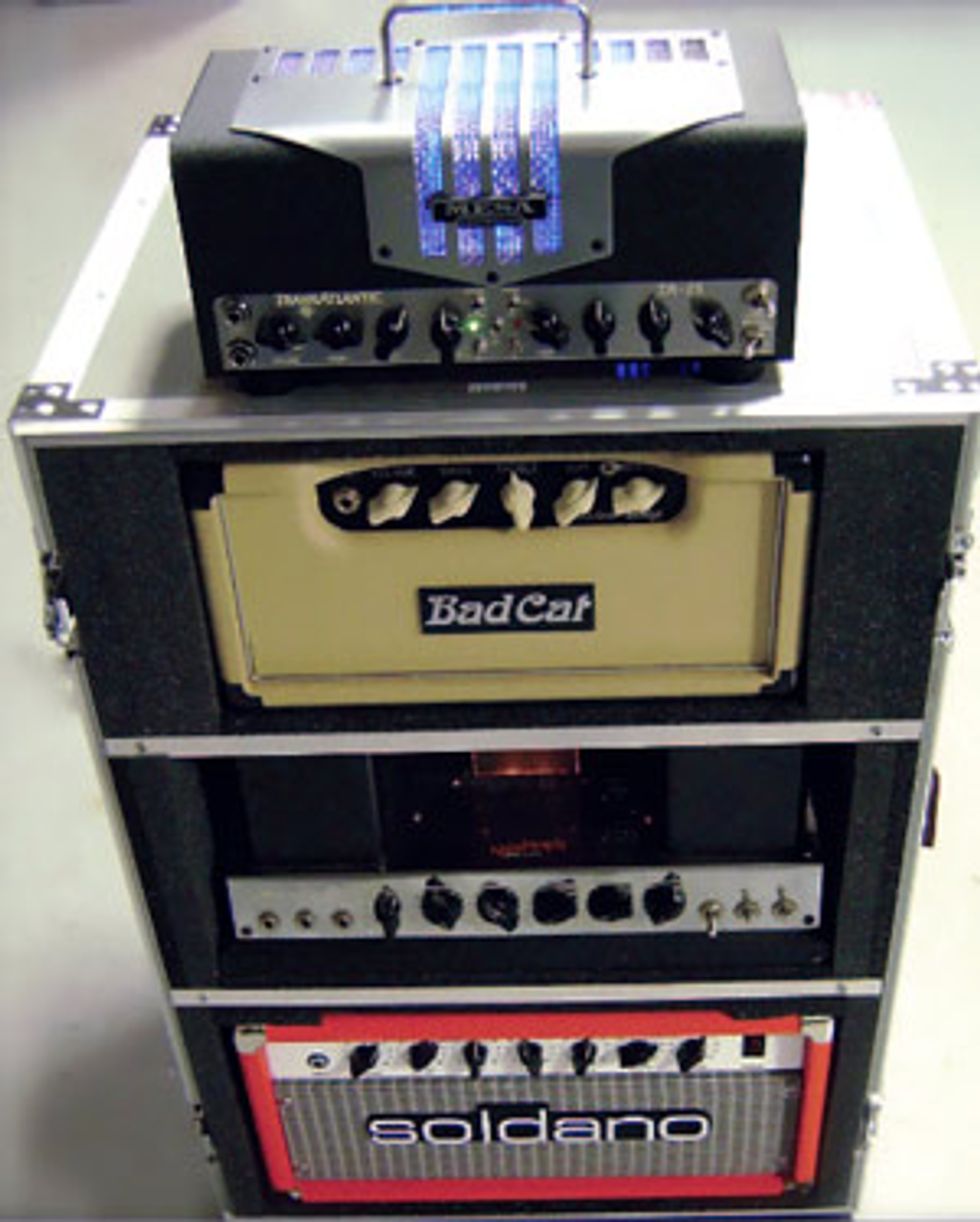
Top to bottom: The Mesa/ Boogie Trans-Atlantic 15, Bad Cat Lil’ 15, 1966 Ampeg B15-N, and Soldano Astroverb 16 offer a wide variety of tones for different applications.
Mesa/Boogie TA-15
Most amps do one particular
sound extremely well and
the rest of the tones are usually
just okay or downright
bad. I think it’s a big part of
the reason that many guitarists
own a bunch of different
amps. The TransAtlantic
TA-15 from Mesa Engineering
is the screaming exception to
this idea. In the same way a
champion triathlete is effective
on wheels, on foot, or in the
water, the TA-15 is a workhorse
in just about any musical
context. Between the amp’s two
channels, I can obtain a lot of
classic tones.
For a ’65 Deluxe Reverb kind of sound, I’ll set the TA-15’s green channel to 15-watt mode and switch to the “normal” setting. I then move the volume and treble to 1 o’clock, and set the bass and master to 2 o’clock. To get a Vox AC-15 vibe happening, I’ll use the same settings just mentioned, except I switch to the “top boost” setting and knock the treble back to 10 o’clock.
When I need high-gain tones, I simply flip over to the red channel. I can get to a tone resembling a late ’60s, 50-watt Plexi on the red channel with the 15-watt setting and dimming the master and bass. From there, I set the treble to 2 o’clock and the gain to 10 o’clock. If I need something more modern sounding, I’ll utilize the 25-watt mode and switch the red channel into the “HI 2” setting. I also boost the gain to 3 o’clock and add a little more treble than I use for the Plexi-type tone.
Bad Cat Lil’ 15
Many of us Nashville guitarists
use the word “spongy” to
describe the tone that lives
right where an amp begins to
breakup between its clean and
overdriven sounds. Listen to
“Days Go By” by Keith Urban
if you want to hear what I’m
talking about. When I need to
get that spongy tone, my Bad
Cat Lil’ 15 is usually the first
place I start. It’s a 1-channel
amp that is sonically similar
to Bad Cat’s Black Cat and is
perfect for getting those rockin’
“in-between” sounds.
The other tonal zip code this amp can deliver is the gritty, Jimmy Page sound that can be heard on Led Zeppelin’s “Heartbreaker.” The setting of the cut knob is the key to getting a clear sound out of this amp and its placement is heavily dictated by which guitar I am playing.
1966 Ampeg B-15 N
Have you ever picked up a
strange guitar and found all
the tones to be weak and
anemic sounding? Whenever
I encounter a guitar with this
thin-type quality, I usually
pair it with my B-15 N to add
some bulk and muscle to the
instrument’s sound. The B-15
N is a really good amp for
trimming out those unwanted
frequencies that bulge out
from certain instruments. For
example, the ringy trebles of
12-string guitars can often
overpower the rest of the frequencies,
resulting in a lack of
fullness to my ear. To achieve
a great, even sound with a
12-string instrument, I’ll run
it into a B-15 N with the
treble set at 2 o’clock and the
bass at 10 o’clock.
An interesting thing about my Ampeg B-15 N is that it has three inputs. When I need to dial-up some aggressive overdriven tones, I’ll join channels 1 and 2 with a patch cable and plug my guitar into the second input of channel 1. This allows me to take advantage of all six of the amp’s control knobs. I set the volume knobs to around 3 o’clock and cut the bass way down on both channels. Most of the time, I’ll set the treble pretty high on one channel and position the amp’s other treble knob to noon. This adds a bit more dimension to the sound than setting both trebles to the same position.
Soldano Astroverb 16 This is the most unique amp of the bunch. After I’ve tracked a heap of different guitar parts for a song, it sometimes becomes difficult to get a new guitar part to poke out and speak through the existing parts. When this happens, I plug into my Astroverb 16 and my problem evaporates. This amp truly has it’s own original character, making it hard to lump it into the typical Fender or Marshall comparisons that are often used when discussing amplifiers. The Astroverb 16 is a great amp for power-chord-driven rock and for solos. And the amp’s reverb is excellent for Santana-like leads when paired with a gain-saturated setting.
You can get plenty of amps to resemble the sound of other amps—it just depends how hard you want to work with pedal combinations and speaker options. I find that it’s best to use an amp for that one, killer sound that it excels at producing. Asking an amp to be something that it’s not will usually lead to frustration. Just be sure to do your due diligence by researching and testing the many amplifier options until you find that one that best suits the job you need it to do.






![Rig Rundown: Russian Circles’ Mike Sullivan [2025]](https://www.premierguitar.com/media-library/youtube.jpg?id=62303631&width=1245&height=700&quality=70&coordinates=0%2C0%2C0%2C0)


























